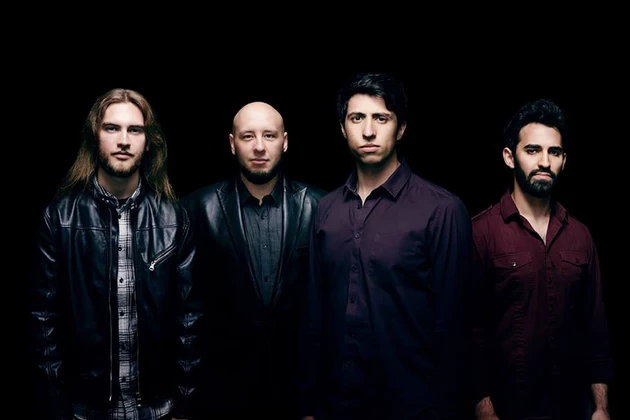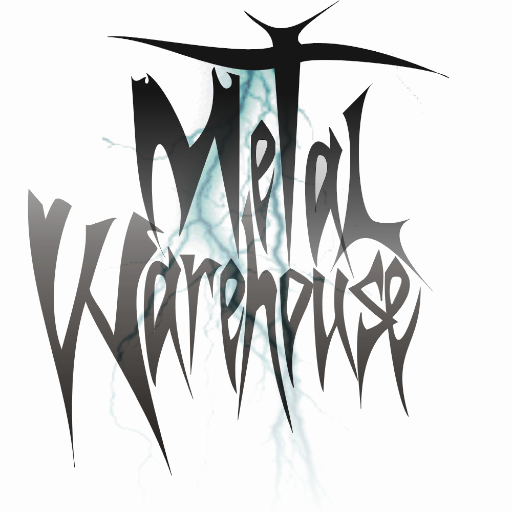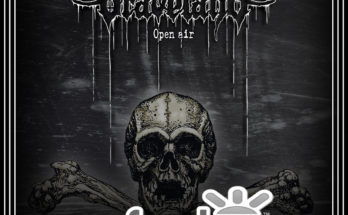 Fresno Media / Photo by Ian Christmann
Fresno Media / Photo by Ian Christmann
Earthside have emerged over the last year with their A Dream in Static album, led by the single “Mob Mentality.” The track was initially part of guitarist Jamie van Dyck’s [pictured center left] senior music thesis at Yale, but evolved over time to include guest vocals by Sevendust‘s Lajon Witherspoon and backing by the Moscow Studio Symphony Orchestra. The video for “Mob Mentality” just completed a five-week run atop Loudwire’s Battle Royale Video Countdown, entering the Battle Royale Hall of Fame. We recently caught up with Earthside guitarist Jamie van Dyck to discuss the success of the song and video and he also gave us an update on what’s next for the band. Check out the interview below.
Congrats on the success of “Mob Mentality.” It was a huge video here in the Loudwire Battle Royale Video Countdown, recently reaching the Battle Royale Hall of Fame. Can you talk about what it meant to you to see the response that fans have given to the song and video?
Thank you! And honestly Loudwire and the Battle Royale have been a big part of the continued success and exposure for “Mob Mentality.” We may not have hundreds of thousands of fans yet, but the ones we do have are incredibly passionate about music. I think the weekly battle sorta galvanized our troops and as the weeks passed and the competition had major industry heavyweights at the top, it motivated them further to go all out for us.
I’m sure people seeing Lajon’s name and familiar face was a major factor in its success as the Sevendust faithful who I’m sure are Loudwire readers have been huge for us as well. Each and every week we were on there, we received multiple messages from new fans saying how much they loved our music and had discovered us through the Battle Royale. It was very cool to see the groundswell of support gain momentum on there. We’re honored to be a part of the Loudwire Battle Royale Hall of Fame and for the response it took for us to get there.
What made Lajon Witherspoon the right vocalist for “Mob Mentality”?
First and foremost, his expressiveness. “Mob Mentality” covers a breadth of emotions in its 10 minutes, and it needed a singer whose voice could express pain, vulnerability, aggression, angst, defeat, triumph, catharsis. LJ’s voice evokes all of that for me at different moments in “Mob” as well as throughout Sevendust’s discography. The song’s subject matter and orchestration demanded that. An orchestra is equally rich at a pianissimo hush as it is at a fortissimo roar, and Lajon’s voice is the same in that regard. I also think that because I grew up with Sevendust as my favorite band in high school, their melodic sensibilities and phrasing probably had a substantial impact on my own vocal writing so I probably unconsciously compose vocal parts right in Lajon’s wheelhouse.
LJ is also just a wonderful person to collaborate with. His attitude and demeanor in the studio created the perfect vibe. The morale was high throughout the vocal sessions, and this is a very challenging song that demands a lot of brainpower and focus from all its performers, especially its vocalist. The whole time, he was positive and was determined to keep going until my Earthside mates and I felt that we had the takes that would bring my vision for the piece to life at its highest aspiration.
I recently spoke with Lajon about his guest turn on the song and he said his biggest regret was not getting a chance to join you in Sweden to perform with the Moscow Studio Symphony Orchestra. Can you discuss what it was like to bring it all together — the band’s playing, Lajon’s vocals and then the Moscow Studio Symphony Orchestra behind you?
I should add that Lajon’s voice also has a distinctiveness to it that gives it an identity to hold its own against something as massive as a full symphony orchestra. I think even a lot of very talented vocalists would be dwarfed by something that grand in scale. As “Mob Mentality” is more personal to me than anything I’ve ever been a part of writing, Lajon gave my soul a voice.
Working with the MSSO was insane. I felt so unprepared, honestly. It was my first time ever composing and arranging for a full orchestra, and it took years to get to that point where it was ready to record. Even still, I’m sure I made tons of orchestration “mistakes.” It’s one of those things where you don’t exactly have an orchestra to try things out on every day, so a lot of it was just reading textbooks, studying my favorite composers’ orchestral scores and learning from them, and ultimately just taking guesses as to what would sound good. I knew what chords and melodies I wanted, but assigning notes in a major arrangement to specific instruments and notating articulations and dynamics – the notation software’s interpretation of those is going to be far different from a human player’s. And then all the time signature changes were not easy on the players to sight read in the studio session. But in the end, as exhilarating and nerve-wracking as it was, we got it! And to have that vision realized with Lajon on vocals and a real full, professional studio orchestra is surreal to me.
I know that “Mob Mentality” is something that’s been with you as the composer for some time. Take us through the journey of the initial idea for the music to seeing it through to its fruition. How was it to see each piece come together for the song?
Yeah, absolutely. The first melodic idea I had for the song was Christmas 2009. I was sitting at the piano just noodling around with my family there. I was probably playing something dark and moody, and I think my uncle asked me to play something uplifting like Billy Joel. I obliged for about 10 seconds, and then I think the rebellious streak in me responded by playing something sinister and dissonant that ended up being the main instrumental theme of the song.
Soon after, I proposed a 10-minute rock song with full symphony orchestra as my senior thesis to complete the music major at Yale, and my professors were cool enough to support it as long as it was orchestra-intensive rather than just the orchestra as background to the rock band.
I went through hot streaks and cold streaks with it creatively as it was totally overwhelming and daunting for me to take this on having never composed for an ensemble even close to that large. I wanted it to be something that I loved and genuinely felt, that my bandmates were really enthusiastic about, and that my professors were impressed by.
Late in composing “Mob Mentality”, my dear friend Ugonna suddenly passed away. Ugonna was a talented songwriter in his own right with a beautiful voice who was only 24 years old, so the song’s themes about legacy and mortality took on a more urgent tone. The song is very much dedicated to him. Ugonna and I went to see a Sevendust concert together early in our friendship so a part of me fantasizes that Ugonna’s spirit helped bring LJ and us together for this song.
When it came to recording the real thing after the demo was finally finished, it was really cool as each demo layer was replaced by the real professionally recorded instrument. First drums, then bass and guitars, then real piano that had been recorded before Sweden was added into the session, and then the real orchestra replacing the programmed orchestra and Lajon’s vocals replacing mine. Each piece of it brought it to a new level so it was ever-evolving and ever-changing. And that was all before we filmed the music video which was an undertaking of its own!
“Mob Mentality” is a part of a bigger album as a whole called “A Dream in Static,” and Earthside are the collective ideal of four very creative people with more cinematic elements added in. What is the creative process like for the group and is there a test for what passes for an Earthside song?
Great question! Each song is its own story as to what goes into creating it, but generally I’d say the songs could be divided into two categories: songs that we write all together in rehearsal (“A Dream In Static,” “The Closest I’ve Come,” “Skyline” and “The Ungrounding”) and songs that one individual brought to the table (“Contemplation of the Beautiful” and Entering the Light” – written by Frank; “Crater” – written by Ben; “Mob Mentality” – written by me). The songs we compose together tend to become instrumentals and the songs we write individually tend to be the ones we invite guest vocalists on. I very much believe that the process which you use to create has a major impact on the final product, and I think because of that the songs that we all write together lend themselves to being complete pieces that form right on the spot with the synergy of whatever we’re feeling and feeding off each other in rehearsal. Whereas in the cases where each of us is on our own, there may be a specific source of inspiration or a topic one of us wants to broach that’s more personal to us that lends itself to lyrics from the get-go.
The main test is simply whether or not we’re all feeling the song. Regardless of who wrote it or how it was written, we try to be as egoless as possible when deciding what makes the record, while also wanting to showcase everybody’s compositional and performance talents over the course of the different songs chosen. A lot of it was also what made the best record as a whole so some of the songs we chose because we felt they showed a side of our sound that we wanted to introduce ourselves with on our debut record. Other songs we wrote may have been plenty worthy, but perhaps were less essential in showing the full spectrum of our sound and our ethos.
I see where “Entering the Light” is now starting to garner some attention for the group. Can you talk about where that song came from? I understand Frank [Sacramone] had the earliest representation of the song back when he was 16.
Yeah, for sure! Every few weeks, we’ve been releasing a video going behind the song in which we talk about the writing process, the recording process, the inspiration, the collaborations, anything else unique about that song, and at this point we have completed and released such videos for 6 of the album’s 8 tracks. “Entering the Light” was the latest in the queue and is a definite case of what I alluded to in my answer to the previous question in that it was chosen for the record unanimously because of how different and refreshing it was compared to other songs in contention that were more similar to the rest of the record.
Like “Mob Mentality”, “Entering the Light” is the only other song to feature our collaboration with the Moscow Studio Symphony Orchestra, but unlike the rest of the record, it utilizes traditional rock instrumentation only sparsely. Its central instrument is the Celtic hammered dulcimer, which is a voice that Frank has had an affinity for dating back to high school as you mentioned with his first iteration of this song. I think there was a hammered dulcimer voice in the music software called Reason in which he made that first demo with all Reason voices – hammered dulcimer, choirs, strings, orchestral drums & percussion, and a few synths, shakers, and ethnic instrument patches all built into Reason and Reason expansions.
Ben [Shanbrom] and I have been playing music with Frank for years now so we were already in a band with him at that time, and I know I immediately gravitated to that piece. “Entering the Light” was my favorite song he’d ever written upon the first time I heard it then, and it’s still among my favorite things Frank has composed even with all the great music he’s written since. Ben and I were both very excited when Frank saw the value in his young adult self re-imagining “Entering the Light” with all real instruments on Earthside’s debut.
The accolades have started coming in and I see that you’ve been nominated for four North American Independent Rock Music Awards. Ultimately you record music for yourself and hope others like it. What does it mean to you to start receiving the critical attention for your work as well?
You nailed it, I think…artists write and record the music that’s meaningful to them, and what matters most is how we feel about our record. And I can say confidently for the first time in our young music career that we’re immensely proud of the music we created together on this album. We were quite critical of the fledgling projects we had in middle school, high school and college and our output before this debut album as Earthside so it’s a relief to finally have created something about which we have no real regrets or ‘cringe’ moments.
To have awards, critics, journalists, and fans all recognize it and feel the same only further amplifies and resonates with that feeling of accomplishment. I think if we weren’t proud of it, it would feel empty and hollow, but because we in large part met our very lofty standards with A Dream in Static and expressed the emotions we wanted to in a meaningful way, it absolutely feels wonderful to have that echoed with others who connect with the music and share in our human experience. We’re very excited to fly out to NAMM next week and be present at the NAIRMA awards ceremony. As Lajon said regarding Sevendust’s recent Grammy nomination, it’d be incredible to win, but just being nominated is an honor that no one can ever take away from you. Hopefully, like our role models in Sevendust, we can stick around making music that’s meaningful to our fans for 20 years and get a Grammy nomination at the end of it, but we have lots of working our ass off to do to get there for sure. These NAIRMA nominations are a tremendous start for our first album, and we’re fortunate to have been recognized among such elite company.
What’s on the horizon for Earthside at this point?
We’re discussing a second music video. We aren’t 100% sure yet what song we’re going to shoot it for, but perhaps it will give us a second shot at a long reign on the Loudwire Battle Royale, eh? “A Dream In Static” just went for adds at metal and loud rock radio, and our song “Crater” featuring Björn “Speed” Strid from Soilwork is especially getting some early love there. If we get some traction there, perhaps we’d push that one to active rock radio as it’s significantly shorter than the 10-minute “Mob Mentality.”
We’re gearing up for another U.S. tour that hasn’t been announced yet, but dates should be up soon. Oh, and we’re going on tour in Europe starting at the end of March and staying over there through early or mid-April! We’re going to be supporting the Norwegian progressive/avant-garde band Leprous in tandem with the Australian band Voyager. Leprous’s The Congregation was probably every member of Earthside’s favorite album to come out in 2015 so it’ll be very cool to be headed out on the road and living on a bus with those dudes! And we’re thrilled to be finally meeting our European fans. Their arts culture in general feels very much in line with our ideals so it will be really great to play music over there and immerse ourselves in that for that first time since recording our album in Sweden.
Our thanks to Earthside’s Jamie van Dyck for the interview. Dig into the band’s A Dream in Static disc by picking up the album via Amazon or iTunes.
Earthside Featuring Lajon Witherspoon & the MSSO, “Mob Mentality”
Subscribe to Loudwire on
![]()
Source: Loudwire.com


